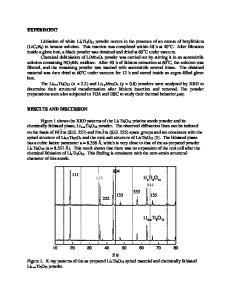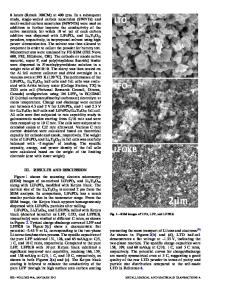Li Ion diffusion measurements in crystalline and amorphous V 2 O 5 thin-film battery cathodes
- PDF / 411,692 Bytes
- 6 Pages / 420.48 x 639 pts Page_size
- 24 Downloads / 322 Views
Mat. Res. Soc. Symp. Proc. Vol. 575 c 2000 Materials Research Society
was deposited at 500 'C and 300 mT 02 with a flow rate of 100 sccm. Film Characterization The crystallinity, phase, and texturing of the films were characterized by X-ray diffraction (XRD) on a Scintag 4-circle diffractometer with Cu-ka radiation. Film thickness measurements were made with a DekTak III profilometer. Inductively coupled plasma (ICP) analysis provided Li to V ratios and film densities. ICP data was confirmed with two independent standards. Film densities were calculated from average thickness measurements, area calculations, and ICP data. Electrochemical Diffusion Measurements All electrochemical testing was conducted in an Argon atmosphere where H 2 0 and 02 levels were < 1 ppm. Electrochemical cells consisted of the cathode film, Li foil counter and reference electrodes and 1 M LiC1O 4 in propylene carbonate (PC) electrolyte. V20 5 film batteries were assembled in glass electrochemical cells and tested in the dry box. Experiments were controlled with an Arbin Instruments four-conductor battery test system with both the positive current and voltage leads connected to the cathode to mimic a standard three-terminal electrochemical cell. The area of film exposed to electrolyte was - 1 cm 2. RESULTS Film Deposition & Characterization Pulsed laser deposition can produce films of various crystallinities and textures by varying the substrate temperature and 02 pressure [3,4]. We have chosen to highlight the results of a typical amorphous film deposited at 35 'C and 20 mTorr 02 and a typical crystalline film deposited at 500 'C and 300 mTorr 02. In Figure 1, the XRD patterns of the SNO 2/7059 substrate and two V 20 5 films deposited under the conditions described earlier are shown. The XRD pattern of the film deposited at 35 'C and 20 mTorr 02 shows no peaks other than those of the Sn0 2 substrate and thus is considered to be amorphous. This film and others deposited under the same deposition conditions show V20O-like Raman scattering spectra (not shown), suggesting V20 5-like short range order. The crystalline film deposited at 500 'C and 300 mTorr 02 exhibits a preferred [(001) & (101)] dual-texturing of this V 20 5 phase, relative to the expected peak intensities for a randomly oriented film. V 20
5
7
10
106
U
0)
10
3
(a)
102 10
20
30
40
500
20 (degrees) Figure 1: XRD patterns of the V20 5 films: (a) SnO2/7059 substrate, (b) 35 °C/20 mTorr 02, (c) 500 °C/300 mTorr 02. The film grown at 500 'C/300 mTorr shows preferential dual [(001) & (101)] texturing. The film grown at 35 'C020 mTorr 02 is amorphous, the peaks present being due to the SnO 2 substrate. 104
The film densities for both the crystalline and the amorphous films were determined to be 95% of the single crystal density. Diffusion Measurements Chemical diffusion coefficients were measured using the potentiostatic intermittent titration technique (PITT) [5]. In this method, the current generated due to an applied voltage step (V, to V2 ) is measured as a funct
Data Loading...











